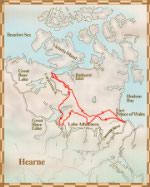 |
|||||||||||
|
|
Samuel Hearne and Matonabbee's Trek to the Arctic OceanThird Expedition
|
||||||||||
 |
| Hearne's third expedition was successful thanks to the help of Matonabbee and his six wives Copyright/Source |
Hearne wanted to learn if there was copper in the North that could be mined. It was decided that Matonabbee would lead this expedition. Matonabbee's six wives carried all of the equipment, prepared the meals and set up camp each night.
In July, the party reached Coppermine River. They met some Inuit and there was a terrible battle. The Inuit were massacred. Hearne named the place Bloody Falls in memory of the fight.
They continued on along the river and arrived at the Arctic Ocean several days later. Hearne only found one four-pound lump of copper. He knew that this was of no use to the Hudson's Bay Company and went back to the Prince of Wales Fort.
Women, Stronger Than Men
According to Matonabbee, Hearne's first two expeditions had been failures because he had had bad guides and no woman to carry things. Matonabbee said,
"Women were made for labour; one of them can carry or haul, as much as two men can do… in fact, there is no such thing as traveling any considerable distance, or for any length of time… without their assistance."
The Illustrated History of Canada. Edited by Craig Brown. Toronto: Lester Pub., ©1991,1987, p. 95.
 | ||
|
At one point during his journey, Hearne's feet were so badly injured from walking over miles of rocky ground, his toenails "festered and dropped off". Every step he took left a bloody footprint. Struzik, Ed. Northwest Passage: The Quest for an Arctic Route to the East. Toronto: Key Porter Books, ©1991, p. 58 |
||
 
|